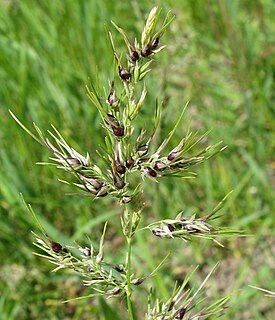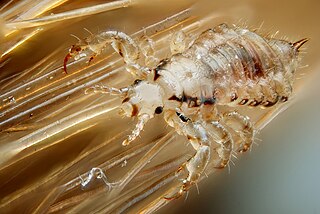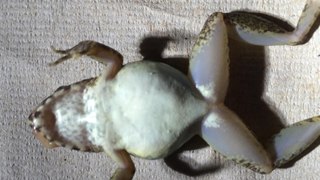Related Research Articles

A noun is a word that functions as the name of a specific object or set of objects, such as living creatures, places, actions, qualities, states of existence, or ideas. However, noun is not a semantic category, so it cannot be characterized in terms of its meaning. Thus, actions and states of existence can also be expressed by verbs, qualities by adjectives, and places by adverbs. Linguistically, a noun is a member of a large, open part of speech whose members can occur as the main word in the subject of a clause, the object of a verb, or the object of a preposition.

An adverb is a word or an expression that modifies a verb, adjective, another adverb, determiner, clause, preposition, or sentence. Adverbs typically express manner, place, time, frequency, degree, level of certainty, etc., answering questions such as how?, in what way?, when?, where?, and to what extent?. This is called the adverbial function, and may be performed by single words (adverbs) or by multi-word adverbial phrases and adverbial clauses.
In traditional grammar, a part of speech or part-of-speech is a category of words that have similar grammatical properties. Words that are assigned to the same part of speech generally display similar syntactic behavior—they play similar roles within the grammatical structure of sentences—and sometimes similar morphology in that they undergo inflection for similar properties.

Fertilisation or fertilization, also known as generative fertilisation, syngamy and impregnation, is the fusion of gametes to give rise to a new individual organism or offspring and initiate its development. Processes such as insemination or pollination which happen before the fusion of gametes are also sometimes informally called fertilization. The cycle of fertilisation and development of new individuals is called sexual reproduction. During double fertilisation in angiosperms the haploid male gamete combines with two haploid polar nuclei to form a triploid primary endosperm nucleus by the process of vegetative fertilisation.

English nouns are inflected for grammatical number, meaning that, if they are of the countable type, they generally have different forms for singular and plural. This article discusses the variety of ways in which English plural nouns are formed from the corresponding singular forms, as well as various issues concerning the usage of singulars and plurals in English. For plurals of pronouns, see English personal pronouns.

A circular definition is one that uses the term(s) being defined as a part of the definition or assumes a prior understanding of the term being defined. There are several kinds of circular definition, and several ways of characterising the term: pragmatic, lexicographic and linguistic.

In botany, apomixis is asexual reproduction without fertilization. Its etymology is Greek for "away from" + "mixing". This definition notably does not mention meiosis. Thus "normal asexual reproduction" of plants, such as propagation from cuttings or leaves, has never been considered to be apomixis, but replacement of the seed by a plantlet or replacement of the flower by bulbils were categorized as types of apomixis. Apomictically produced offspring are genetically identical to the parent plant.
A gerund is any of various nonfinite verb forms in various languages; most often, but not exclusively, one that functions as a noun. In English, it has the properties of both verb and noun, such as being modifiable by an adverb and being able to take a direct object. The term "-ing form" is often used in English to refer to the gerund specifically. Traditional grammar makes a distinction within -ing forms between present participles and gerunds, a distinction that is not observed in such modern, linguistically informed grammars as A Comprehensive Grammar of the English Language and The Cambridge Grammar of the English Language.

The egg cell, or ovum, is the female reproductive cell, or gamete, in most anisogamous organisms. The term is used when the female gamete is not capable of movement (non-motile). If the male gamete (sperm) is capable of movement, the type of sexual reproduction is also classified as oogamous.
In linguistics, a participle is a nonfinite verb form that has some of the characteristics and functions of both verbs and adjectives. More narrowly, participle has been defined as "a word derived from a verb and used as an adjective, as in a laughing face".

The head louse is an obligate ectoparasite of humans.

Ovoviviparity, ovovivipary, ovivipary, or aplacental viviparity is an outmoded term used as a "bridging" form of reproduction between egg-laying oviparous and live-bearing viviparous reproduction. Ovoviviparous animals have the embryos develop inside eggs that remain in the mother's body until they are ready to hatch.
An auto-antonym or autantonym, also called a contronym, contranym or Janus word, is a word with multiple meanings (senses) of which one is the reverse of another. For example, the word cleave can mean "to cut apart" or "to bind together". This phenomenon is called enantiosemy, enantionymy, antilogy or autantonymy. An enantiosemic term is necessarily polysemic.

Fasciola gigantica is a parasitic flatworm of the class Trematoda, which causes tropical fascioliasis. It is regarded as one of the most important single platyhelminth infections of ruminants in Asia and Africa. Estimates of infection rates are as high as 80–100% in some countries. The infection is commonly called fasciolosis.
A trophic egg, in most species that produce them, usually is an unfertilised egg because its function is not reproduction but nutrition; in essence it serves as food for offspring hatched from viable eggs. The production of trophic eggs has been observed in a highly diverse range of species, including fish, amphibians, spiders and insects. The function is not limited to any particular level of parental care, but occurs in sub-social species of insects, such as the spider A. ferox, as well as a few other species like the frogs Leptodactylus fallax and Oophaga, and the catfish Bagrus meridionalis.
The grammar of Old English is quite different from that of Modern English, predominantly by being much more inflected. As an old Germanic language, Old English has a morphological system that is similar to that of the hypothetical Proto-Germanic reconstruction, retaining many of the inflections thought to have been common in Proto-Indo-European and also including constructions characteristic of the Germanic daughter languages such as the umlaut.
English orthography sometimes uses the term proper adjective to mean adjectives that take initial capital letters, and common adjective to mean those that do not. For example, a person from India is Indian. Indian is a proper adjectives.
The grammar of the Marathi language shares similarities with other modern Indo-Aryan languages such as Odia, Gujarati or Punjabi. The first modern book exclusively on Marathi Grammar was printed in 1805 by Willam Carey.

Fasciolopsis is a genus of trematodes. They are also known as the intestinal flukes.
Gnathostoma hispidum is a nematode (roundworm) that infects many vertebrate animals including humans. Infection of Gnathostoma hispidum, like many species of Gnathostoma causes the disease gnathostomiasis due to the migration of immature worms in the tissues.
References
- ↑ Brown, Lesley (1993). The New shorter Oxford English dictionary on historical principles . Oxford [Eng.]: Clarendon. ISBN 978-0-19-861271-1.
- ↑ Gerba, Charles P.; Maier, Raina M.; Pepper, Ian L. (2009). Environmental microbiology. Amsterdam: Elsevier Academic Press. ISBN 978-0-12-370519-8.
- ↑ Lin, Paul P. C.: Effects of methylglyoxal-bis (guanylhydrazone) and abscisic acid on polyamine metabolism in embryonectomized barley seeds. Pub: Plant Growth Regulation Volume 3, Numbers 3-4, 257-268, doi : 10.1007/BF00117584
- ↑ M. Al Jabr Ahmed : Effect of Bruchid Beetles (Bruchidius Arabicus Decelle) Infestation on the Germination of Acacia tortilis (Forssk.) Hayne) Seeds : American Journal of Environmental Sciences 4 (4): 285-288, 2008 ISSN 1553-345X
- ↑ Knipe, David (2007). Fields' Virology. Philadelphia: Wolters Kluwer Health/Lippincott Williams & Wilkins. ISBN 978-0-7817-6060-7.
- ↑ Burgess IF (1995). "Human lice and their management". Advances in Parasitology. 36: 271–342. doi:10.1016/S0065-308X(08)60493-5. ISBN 9780120317363. PMID 7484466.
- ↑ Robert W. Tolan, Jr.; Fascioliasis Due to Fasciola hepatica and Fasciola gigantica Infection. Posted: 01/30/2011; Laboratory Medicine. 2011;42(2):107-116. © 2011 American Society for Clinical Pathology